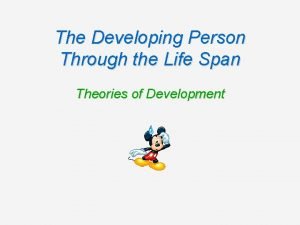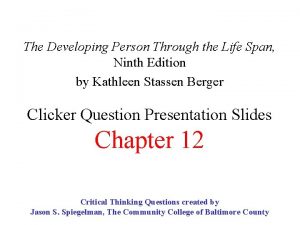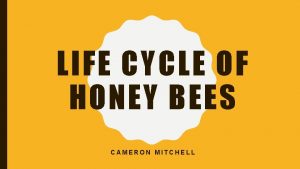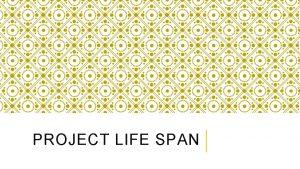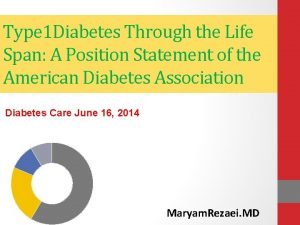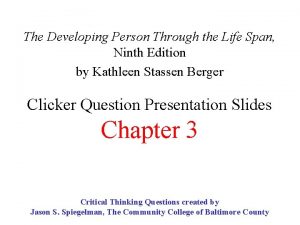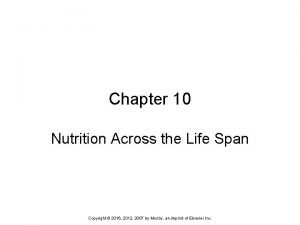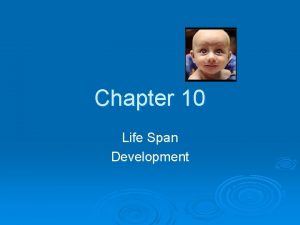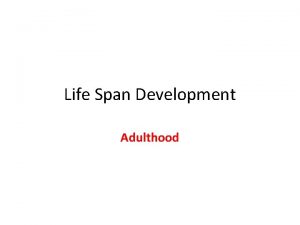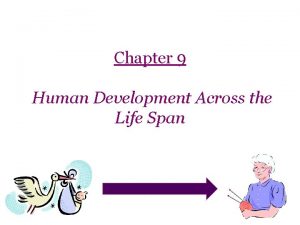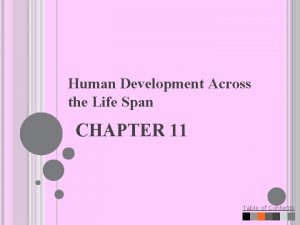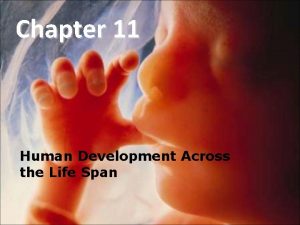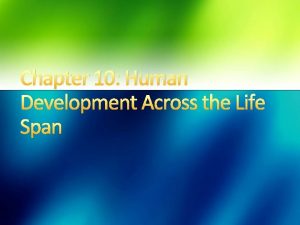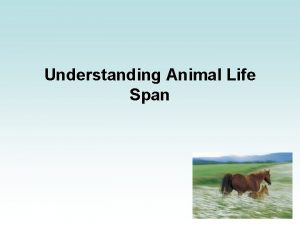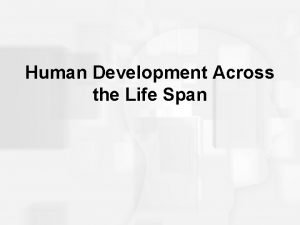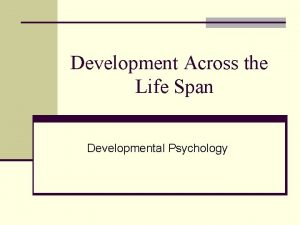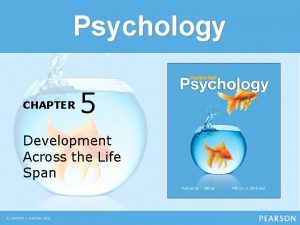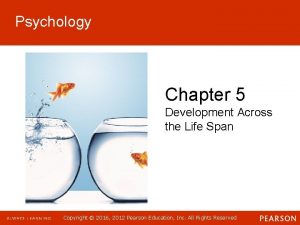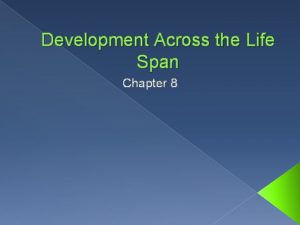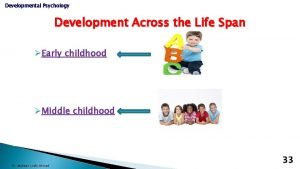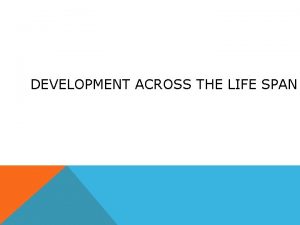Chapter 11 Human Development Across the Life Span
























- Slides: 24

Chapter 11: Human Development Across the Life Span

Progress Before Birth: Prenatal Development • 3 phases – germinal stage = first 2 weeks • conception, implantation, formation of placenta – embryonic stage = 2 weeks – 2 months • formation of vital organs and systems – fetal stage = 2 months – birth • bodily growth continues, movement capability begins, brain cells multiply • age of viability

Figure 11. 1 Overview of fetal development

Environmental Factors and Prenatal Development • Maternal nutrition – Malnutrition linked to increased risk of birth complications, neurological problems, and psychopathology • Maternal drug use – Tobacco, alcohol, prescription, and recreational drugs – Fetal alcohol syndrome

Environmental Factors and Prenatal Development • Maternal illness – Rubella, syphilis, mumps, genital herpes, AIDS, severe influenza – Prenatal health care – Prevention through guidance

The Childhood Years: Motor Development • Basic Principles – Cephalocaudal trend – head to foot – Proximodistal trend – center-outward • Maturation – gradual unfolding of genetic blueprint • Developmental norms – median age – Cultural variations

Easy and Difficult Babies: Differences in Temperament • Longitudinal vs. cross-sectional designs • Thomas, Chess, and Birch (1970) – 3 basic temperamental styles • easy – 40% • slow-to-warm-up – 15% • difficult – 10% • mixed – 35% – stable over time

Easy and Difficult Babies: Differences in Temperament • Kagan & Snidman (1991) – Inhibited vs. uninhibited temperament • inhibited – 15 - 20% • uninhibited – 25 - 30% – stable over time, genetically based

Figure 11. 6 Longitudinal versus cross-sectional research

Early Emotional Development: Attachment • Separation anxiety – Ainsworth (1979) – The strange situation and patterns of attachment • Secure • Anxious-ambivalent • Avoidant • Developing secure attachment – Bonding at birth – Daycare – Cultural factors • Evolutionary perspectives on attachment

Stage Theories of Development: Personality • Stage theories, three components – progress through stages in order – progress through stages related to age – major discontinuities in development • Erikson (1963) – Eight stages spanning the lifespan – Psychosocial crises determining balance between opposing polarities in personality

Figure 11. 10 Stage theories of development

Figure 11. 11 Erikson’s stage theory

Stage Theories: Cognitive Development • Jean Piaget (1920 s-1980 s) – Assimilation/ Accommodation – 4 stages and major milestones • Sensorimotor – Object permanence • Preoperational – Centration, Egocentrism • Concrete Operational – Decentration, Reversibility, Conservation • Formal Operational – Abstraction

Figure 11. 12 Piaget’s stage theory

Figure 11. 13 Piaget’s conservation task

Figure 11. 14 The gradual mastery of conservation

The Development of Moral Reasoning • Kohlberg (1976) – Reasoning as opposed to behavior • Moral dilemmas – Measured nature and progression of moral reasoning – 3 levels, each with 2 sublevels • Preconventional • Conventional • Postconventional

Figure 11. 17 Kohlberg’s stage theory

Adolescence: Physiological Changes • Pubescence • Puberty – Secondary sex characteristics – Primary sex characteristics • Menarche • Sperm production – Maturation: early vs. late • Sex differences in effects of early maturation

Figure 11. 19 Physical development at puberty

Adolescence: Neural Changes • Increasing myelinization • Synaptic pruning • Changes in prefrontal cortex

The Search for Identity • Erikson (1968) – Key challenge - forming a sense of identity • James Marcia (1988) – 4 identity statuses • Foreclosure • Moratorium • Identity Diffusion • Identity Achievement

The Expanse of Adulthood • • • Personality development Social development Career development Physical changes Cognitive changes
 Chapter 7 life span development
Chapter 7 life span development Cna chapter 8 human needs and human development
Cna chapter 8 human needs and human development Chapter 8 human needs and human development
Chapter 8 human needs and human development Life cycle of painted lady butterfly
Life cycle of painted lady butterfly Immortal jellyfish habitat
Immortal jellyfish habitat Eagle lifespan 70 years
Eagle lifespan 70 years Life span theories
Life span theories The developing person through the life span 9th edition
The developing person through the life span 9th edition Honey bee life cycle
Honey bee life cycle Life span of fruit to be used in a caramel petit fours.
Life span of fruit to be used in a caramel petit fours. Project life span
Project life span The developing person through the life span 9th edition
The developing person through the life span 9th edition Ozymandias summary line by line
Ozymandias summary line by line Life span type 1 diabetes
Life span type 1 diabetes The developing person through the life span 9th edition
The developing person through the life span 9th edition Gni definition ap human geography
Gni definition ap human geography Physical quality of life index and human development index
Physical quality of life index and human development index Genetic effects on gene expression across human tissues
Genetic effects on gene expression across human tissues Patterns of development in writing across disciplines
Patterns of development in writing across disciplines Nutrition across life stages
Nutrition across life stages Diversity and human needs and development
Diversity and human needs and development Chapter 36 section 2 human development before birth
Chapter 36 section 2 human development before birth Infancy psychosocial development
Infancy psychosocial development Hình ảnh bộ gõ cơ thể búng tay
Hình ảnh bộ gõ cơ thể búng tay Slidetodoc
Slidetodoc






